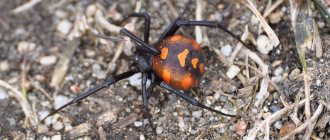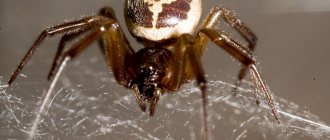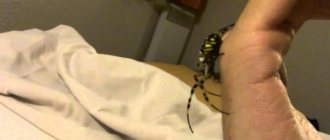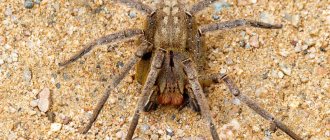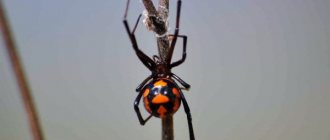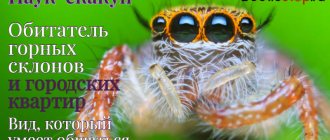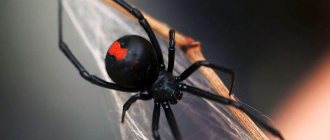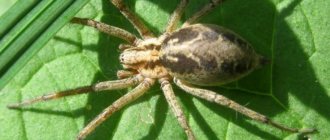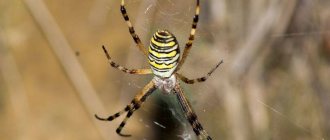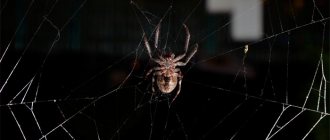Nature has endowed each dangerous spider with quite powerful poisonous fangs that paralyze the victim. The spider's venom is so strong that it can literally turn the victim's body tissue into slurry. There are about forty-two thousand species of spiders on Earth, but only a few pose a threat to human life. Due to its size, it is difficult for a spider to bite through human skin, but if it succeeds, it is unlikely to cause serious harm to health. However, there are a number of spiders that can kill a person. It is these species that we will talk about today. We recommend that you get acquainted with ten far from harmless, but even the most dangerous spiders in the world.
Karakurt - the most dangerous spider in the world
Karakurt, or as it is also called, the black widow, cannot boast of its impressive size, but it is capable of producing such a powerful poison, in which the content of neurotoxins is many times higher than that of a cobra. After being bitten by a dangerous karakurt spider, a person feels a sharp pain that spreads throughout the body within half an hour. The next five days of the bitten person pass as if in a fog, with weakness, dizziness and vomiting. If the victim is not given appropriate assistance, he will die. Only female karakurts pose a danger to the life of Homo sapiens, since males very often become victims themselves. The habitats of the most dangerous spider are the steppes of Ukraine, Russia, Kyrgyzstan and Kazakhstan.
Cyclocosmia
A spider with a “seal” on the back of its body makes a very unpleasant impression. Especially his thick short legs and his belly, as if cut off at the end. The size of Cyclocosmia usually does not exceed 7-8 cm, taking into account the paw span. The fleshy, plump abdomen ends in a chitinous disc, which is covered with sharp spines. If the spider is in danger, it crawls into the hole, putting its “shield” out. These strange creatures live in the southern states of the USA and some Asian countries and have an aggressive character. They are not dangerous to humans, but they can bite very painfully.
Sydney funnel web spider - one of the 10 most dangerous spiders
The Sydney funnel web spider is very aggressive and always attacks humans first. Its bite causes paralysis of the human nervous and respiratory system. Males are more poisonous than females and more confident, and therefore fearlessly penetrate human dwellings. The victim needs to be administered an antidote as soon as possible; it’s good that this type of dangerous spider lives in Sydney, where an antidote was invented long ago.
Horrible in person
But almost cute on the inside. All tarantulas are poisonous, but their venom is low-toxic and the bite of these spiders is not dangerous to humans. Unless the victim has an allergic reaction to spider venom. But in this case, the size of the spider is not so important.
If you arrange spiders in descending order, you will get something like this rating:
- Theraphosa blondi (Goliath species).
- Heteropoda maxima (species of Heteropoda maxima).
- Acanthoscurria (genus of spiders Acanthoscurria).
- Nhandu coloratovillosus (Coloratovillosus species).
- Nhandu tripepii (Nandu tripepii species).
- Brachypelma smithi (Species of Brachypelma smithi).
- Lampropelma nigerrimum (Lampropelma nigerrimum species).
- Lampropelma nigerrimum arboricola (species Lampropelma nigerrimum arboricola).
- Aphonopelma seemanni (species of Aphonopelma zemanni).
- Avicularia purpurea (Species of Avicularia purpura).
On a note!
The size of a spider is usually determined by the span of its legs, since the body can be quite tiny. From this point of view, Heteropoda maxima should be in first place, since it surpasses Goliath in the length of its legs. But Goliath looks more impressive.
Goliath
The female's body grows up to 10 cm. Males are smaller - 8.5 cm. The paw span can be 28 cm. The color is dark brown. The body is completely covered with short reddish-brown bristles. Lives in the tropical zone of South America.
The most terrible spiders
On a note!
Although a goliath's bite is not dangerous, its venom can cause skin irritation. More serious damage is caused by the bristles, which are the spider’s main defense. Easily separated from the tarantula's body, the bristles cause an allergic skin reaction in humans.
Heteropoda maxima
It rivals Goliath in size, although the female’s body length is only 4.6 cm, the male’s is 3 cm. But the limb span is 25-30 cm. The species was recently discovered in Laos. The color of spiders is brownish-yellow. There are no gender differences in color. Presumably the species lives in caves. The toxicity level of the venom and the strength of the bite are unknown. But this tarantula looks really creepy. Especially because of the large chelicerae.
Acantoscuria
This is a genus of large spiders. The paw span of the smallest species is 12 cm. The largest is 22 cm. The color is dark brown with a light border along the cephalothorax and light stripes on the paws. Outwardly it resembles the South Russian tarantula, but has a more attractive appearance.
Nervous character. If disturbed, it may bite. Considering the easily excitable nervous system of arthropods and their number in tarantula lovers, the venom of representatives of this genus is low-toxic.
Rhea coloratovillosus
The body and paws of the animal are covered with thick and long reddish bristles. The length of the female is up to 9 cm. The paw span is up to 18 cm. A native of Brazil. Stubble that easily falls out poses a danger to humans.
Rhea thriperia
A very fluffy arthropod whose pink or red bristles perform a protective function. Therefore, the spider itself does not exchange bites and is valued for its docile disposition. The paw span is up to 18 cm. Females grow up to 8 cm, males up to 5 cm. Country of origin is Brazil.
The most terrible spiders
Brachypelma smithy
The body dimensions are close to Goliath: up to 9 cm. The paw span is up to 17 cm. The tarantula has a very beautiful coloring: a dark background with red spots on the paws. With age, the contrast intensifies.
It uses bristles as protection, since the poison is slightly toxic. The bite is not dangerous to humans. In addition, the animal has a very calm disposition.
Lampropelma nigerrium
The body size of adult individuals is 6-8 cm. The paw span is 17-19 cm. In particularly large specimens, the leg span can be 20 cm. The color of females is jet black, males are ashen, with a striped pattern on the abdomen.
On a note!
The character is vile: fast, aggressive and unpredictable, without hesitation he bites. The poison is dangerous for humans.
Lampropelma nigerrium arboricola
Body size up to 8 cm, paw span up to 18 cm. Females are black, males are ash-yellow. Animals are burrowers. They hunt at night.
The character is similar to its brother in its genus: an aggressive, fast arthropod with strong poison. In the absence of shelter, it is prone to bites. The poison can cause several unpleasant days for a person.
Afonopelma zemanni
The paw span is up to 14 cm. The color is black or dark brown with light stripes on the paws. They are nocturnal. Fast and active only at night. The rest of the time they prefer to sit in shelters, as they do not like sunlight.
The poison is weak. The bite is similar in strength to that of a wasp. When a person is bitten, local irritation and swelling go away on their own after 2-3 days.
The most terrible spiders
Avicularia purpura
An inhabitant of Ecuador in nature builds nests in hollows. Likes to use voids in human habitation for nesting. Completely covered with thick black bristles that glow purple-blue in the sun. Grows up to 6 cm. Leg span up to 14 cm.
Protection is provided by irritating bristles, since the venom is weak and the bite is not dangerous to humans.
Although photos of scary tarantula spiders make an impression, it is not these giants that are truly dangerous, but modest little spiders. Often these spiders have an inconspicuous camouflage color.
The Australian widow is one of the most dangerous poisonous spiders
Every resident of Australia knows this dangerous spider. The Australian widow spider differs in appearance from other spiders. It has a red longitudinal mark on its round belly. The spider lives in urban environments, and therefore its encounters with humans are not uncommon. During the bite, the Australian widow controls the dosage of the poison, but small children and elderly people die without the necessary medical care. After the bite of the Australian widow, swelling, colic, excessive sweating and unpleasant nausea persist for a long time.
Linotele fallax
This spider is called a tiger spider for its similarity in color to a mammalian predator. Its body is approximately 4 cm in length, and with its paws spread it reaches 10-12 cm. These “tigers” are found in Bolivia. They dig deep holes for themselves, entangling them with an incredibly thick web, like something out of a horror movie. Despite its terrifying appearance, linotele fallax is popular among spider lovers, and is often kept as a pet.
North American black widow
The terrible name of a spider does not make a dangerous representative of the order of arthropods a maniac killer. The black widow injects a poison that causes a terrible allergic reaction. Over the past hundred years, thirteen people have died from black widow bites, although before the development of a vaccine, more than five percent of those bitten died. North America, New Zealand and Australia - these are the regions where dangerous representatives of the order arthropods live.
Who is scarier
Speed and aggressiveness should also be added to the criteria for evaluating scary spiders. What is the use of strong poison if the spider moves slowly and is only able to catch prey sitting still.
Interesting!
The fastest spiders today are the crab spiders, which wait in ambush for prey. It is unknown how strong their poison is, since the arthropods are small and do not bite humans. But the speed of rotation of their body when catching prey reaches 3000° per second. That is, in a second, a crab spider can rotate around its axis 8 times.
If you choose creepy spiders by size, then the entire top 10 scary spiders will be occupied by tarantulas.
Brown recluse spider
The brown recluse spider is also called the fiddle spider. It is found in the south in the USA and northern Mexico. Residents of these regions try to avoid contact with the recluse spider, as its venom is toxic enough to kill a person. After exposure to toxic substances contained in the venom of a recluse spider, tissue rejection begins at the site of the bite, which without medical assistance can lead to tragic fatal consequences.
Goliath tarantula
The size of this giant alone can scare anyone. Goliath is considered the largest spider on the planet, since its body length is 9 cm, and its paw span reaches 27-28 cm. Giant spiders settled in South America. They prefer to settle away from people, but arachnophiles do not agree with them, and many of them keep goliaths in their terrariums. Despite its menacing size and powerful fangs, the tarantula is not capable of killing a person, but it can bite very unpleasantly.
Brazilian wandering spider
The jumping and lightning-fast wandering spider very easily penetrates into a home, car, bag, and clothing pockets. A contact encounter with a Brazilian spider usually ends in paralysis of the muscular system and suffocation. Although poison rarely causes death, it is still unpleasant to feel the effects of toxins with a lack of air. Men should generally avoid contact with the wandering spider, as there is a high risk of becoming impotent after being bitten.
Features of character and lifestyle
Photo: Camel spider in Crimea
Bihors are very active. They hunt mainly at night, although diurnal species are also found. During the winter, arthropods hibernate, and some species can do so during the summer months. They received the name “Wind Scorpion” for their ability to move at a speed of 16 kilometers per hour. Large individuals jump at a distance of more than one meter.
These creatures are aggressive, but not at all poisonous, although their bites can have serious consequences. Large individuals are capable of biting through human skin or nails. If rotting remains of their victims are present on the mandibles, they can enter the wound and cause blood poisoning or, at a minimum, inflammation.
The creature is absolutely not afraid of people. At night, phalanxes can easily run into the tent by the light of a lantern, so the entrance should always be closed. And when climbing inside, it’s better to check once again whether the animal has run in with you. Personal belongings also need to be kept in the tent, since a salpuga tired after a night hunt can climb into them to rest.
It is impossible to kick a bihork out of the tent. She is very nimble and persistent, so all that remains is to kill her or sweep her with a broom. It is advisable to do all this with thick gloves, and it is better to tuck your trousers into your boots. It should be remembered that it is impossible to crush an animal on the sand.
Best articles: Animals of cold regions of the world - characteristics, interesting facts and photos
The six-eyed sand spider is a dangerous representative of the order of arthropods
The six-eyed sand spider earned its name due to the fact that it is quite skillful at burrowing into the sand and hunting prey. Nature did not reward the six-eyed sand spider with the ability to weave a web. This feature distinguishes this representative from other classes of spiders. The bite of this dangerous spider causes hemorrhage, but science knows of only two cases of death. Scientists conducted more than one experiment on rabbits, as a result of which all experimental subjects died after being bitten by a six-eyed spider.
Missoulaena
They feed on insects and lead a measured lifestyle, but use poison for self-defense. In nature, everything is interconnected, and poisonous missulens themselves become food for some types of wasps, as well as poisonous scorpions. For many years there has been a story among people that these creatures can dig deep holes, and therefore they are also called mouse spiders.
The poison has a protein base. The components affect the nervous system. Spiders do not show aggression. Only 40 cases of bites have been recorded in history. Severe symptoms requiring medical intervention appeared only in 10 cases. But it’s better to bypass this spider and not tempt fate.
9
Tarantula - the largest dangerous spider
The tarantula is the largest representative of the arachnid class in the world, which lives in the desert or arid steppe. For humans, tarantula venom is not fatal and only causes swelling. Legends about the poisonousness of the tarantula have been circulating for centuries. Entire epidemics have been linked to a single tarantula bite. Even a dance called “tarantella” arose thanks to the myth that frantic dancing saves you from a tarantula bite.
Today we introduced you to ten dangerous spiders that pose a threat to human life. Try to avoid contact with the above dangerous spiders, which nature has awarded with a real opportunity to “defeat a person” in the literal sense of this expression. Don't risk your life. Be vigilant and careful!
Sak
What are the most dangerous spiders in tenth place in the presented ranking? These arthropods are called golden or golden ones. We are talking about yellow saka spiders, which live mainly in Europe. This small (up to 1 cm in length) arthropod builds itself a bag-like shelter. Sometimes sakis simply sit out inside their house. The bites of these spiders are clinically dangerous and cause extensive tissue necrosis. However, fortunately, golden sakis are not at all aggressive. They can attack people only when there is a feeling of danger.

